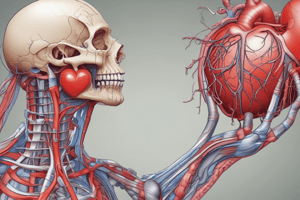Podcast
Questions and Answers
What is the outer layer of the heart wall called?
What is the outer layer of the heart wall called?
- Epicardium (correct)
- Pericardium
- Myocardium
- Endocardium
Which chamber of the heart receives deoxygenated blood from the systemic veins?
Which chamber of the heart receives deoxygenated blood from the systemic veins?
- Right ventricle
- Left atrium
- Right atrium (correct)
- Left ventricle
What supplies blood to the walls of the myocardium?
What supplies blood to the walls of the myocardium?
- Ascending aorta
- Coronary arteries (correct)
- Systemic veins
- Pulmonary veins
Which layer forms the epicardium of the heart?
Which layer forms the epicardium of the heart?
How many chambers does the human heart have?
How many chambers does the human heart have?
What type of valves are responsible for keeping the blood flowing in the correct direction in the heart?
What type of valves are responsible for keeping the blood flowing in the correct direction in the heart?
Which valve is located between the right ventricle and the pulmonary trunk?
Which valve is located between the right ventricle and the pulmonary trunk?
During ventricular relaxation, which valves close to prevent blood from flowing back into the ventricles?
During ventricular relaxation, which valves close to prevent blood from flowing back into the ventricles?
What is the function of the heart's conduction system in controlling the heartbeat?
What is the function of the heart's conduction system in controlling the heartbeat?
Why does the myocardium of the heart wall need an extensive network of blood vessels?
Why does the myocardium of the heart wall need an extensive network of blood vessels?
Study Notes
Anatomy and Physiology of the Heart
Heart Structure
The human heart is a four-chambered muscular organ, shaped and sized roughly like a man's closed fist with two-thirds of the mass on the left side. The heart is enclosed in a pericardial sac that is lined with the parietal layers of a serous membrane. The visceral layer of the serous membrane forms the epicardium.
Three layers of tissue form the heart wall: the outer layer of the heart wall is the epicardium, the middle layer is the myocardium, and the inner layer is the endocardium. The right and left coronary arteries, branches of the ascending aorta, supply blood to the walls of the myocardium.
Heart Functions
The heart is the primary organ in the cardiovascular system, responsible for pumping blood throughout the body. It constantly sends oxygen to the cells and tissues and takes away waste. The heart has four chambers: two atria on the top and two ventricles on the bottom. The right atrium receives deoxygenated blood from systemic veins, while the left atrium receives oxygenated blood from the pulmonary veins.
The heart is divided into two pumps, one on the right and one on the left. Blood flows from the right atrium to the right ventricle, then is pumped to the lungs to receive oxygen. From the lungs, the blood flows to the left atrium, then to the left ventricle. From there, it is pumped to the systemic circulation.
The heart also has two types of valves that keep the blood flowing in the correct direction: atrioventricular valves (also called cuspid valves) and semilunar valves. The right atrioventricular valve is the tricuspid valve, and the left atrioventricular valve is the bicuspid, or mitral, valve. The valve between the right ventricle and pulmonary trunk is the pulmonary semilunar valve, and the valve between the left ventricle and the aorta is the aortic semilunar valve.
When the ventricles contract, atrioventricular valves close to prevent blood from flowing back into the atria. When the ventricles relax, semilunar valves close to prevent blood from flowing back into the ventricles.
The myocardium of the heart wall is a working muscle that needs a continuous supply of oxygen and nutrients to function efficiently. For this reason, cardiac muscle has an extensive network of blood vessels to bring oxygen to the contracting cells and to remove waste products.
The heart's conduction system is like the electrical wiring of a building, controlling the rhythm and pace of the heartbeat. Signals start at the top of the heart and move down to the bottom.
Studying That Suits You
Use AI to generate personalized quizzes and flashcards to suit your learning preferences.
Description
Explore the detailed anatomy and functions of the heart, including its structure, chambers, walls, valves, blood flow, myocardium, and conduction system. Learn about the four-chambered muscular organ's role in pumping blood throughout the body and maintaining circulation.




